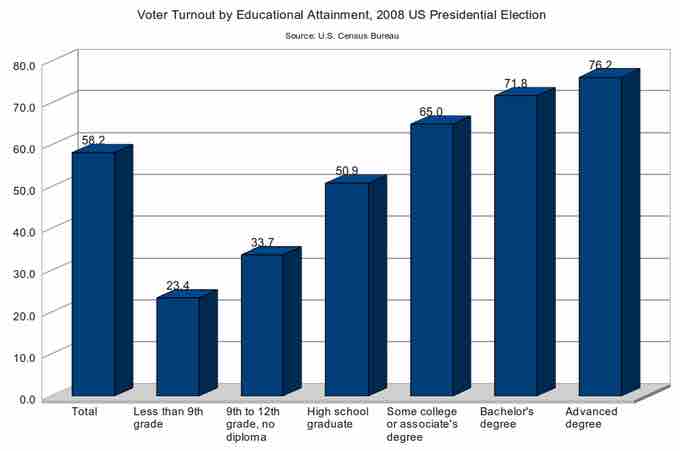Voter Turnout
Voter turnout is the percentage of eligible voters who cast a ballot in an election. "Eligible voters" are defined differently in different countries, and the term should not be confused with the total adult population. After increasing for many decades, there has been a trend of decreasing voter turnout in most established democracies since the 1960s . In general, low turnout may be due to disenchantment, indifference, or contentment. Low turnout is often considered to be undesirable, and there is much debate over the factors that affect turnout and how to increase it. In spite of significant study devoted to the issue, scholars are divided on reasons for the decline. The causes of decreasing turnout have been attributed to a wide array of economic, demographic, cultural, technological, and institutional factors. There have been many efforts to increase turnout and encourage voting.

Voter turnout over time for five countries
Change in voter turnout over time for five selected countries.
In each nation, some parts of society are more likely to vote than others. In high-turnout nations, these differences tend to be limited: as turnout approaches 90 percent, it becomes difficult to find differences of much significance between voters and nonvoters. In low turnout nations, however, the differences between voters and non-voters can be quite marked. Socioeconomic factors significantly affect whether or not individuals voting tendencies. The most important socioeconomic factor in voter turnout is education. The more educated a person is, the more likely he or she is to vote, even when controlling for other factors such as income and class that are closely associated with education level .

Voter Turnout by Educational Attainment –2008 Presidential Election
Educational attainment, an indicator of social class, can predict one's level of political participation. Those with high educational attainment are more likely to vote in elections than those with little education.
Gender, Age, Ethnicity, Race, Income
There is some debate over the effects of ethnicity, race, and gender on voter turnout. While women are generally as likely as men to vote in developed countries, women are underrepresented in political positions. Women make up a very small percentage of elected officials, both at local and national levels. In the U.S., for instance, in the 109th Congress (2005-2007) there were only 14 female Senators (out of 100) and 70 Congressional Representatives (out of 435).
Age is another crucial factor determining voter turnout. Young people are much less likely to vote than are older people, and they are less likely to be politicians. The lower voting rates of young people in the U.S. help explain why things like Medicare and Social Security in the U.S. are facing looming crises: the elderly will retain many of the benefits of these programs and are unwilling to allow them to be changed even though young people will be the ones to suffer the consequences of these crises.
Generally, racial and ethnic minorities are less likely to vote in elections and are also underrepresented in political positions. If blacks were represented in proportion to their numbers in the U.S., there should be 12 Senators and 52 Members of the House. In 2009, there was 1 black Senator (Roland Burris) and 39 Members of the House. In 2010, the number in the House increased slightly to 41 (7.8 percent), but remained at just 1 percent of the Senate.
Political power is also stratified through income and education. Wealthier and more educated people are more likely to vote. Additionally, wealthier and more educated people are more likely to hold political positions. In the 2004 U.S. Presidential Election, the candidates, John Kerry, and George W. Bush, were both Yale University alumni. John Kerry was a lawyer and George W. Bush had an MBA from Harvard. Both were white, worth millions of dollars, and came from families involved in politics.